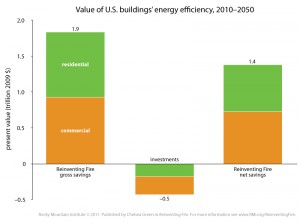Background
There has been renewed interest in building energy efficiency over the last several years. Applying smart information technology, existing efficiency improvements and better metering and data management could well transform building energy consumption.

Amory Lovins’ 2011 book on the state of the energy industry, called Reinventing Fire: Bold Business Solutions for the New Energy Era devotes a chapter to the energy efficiency potential in the buildings sector. He writes that buildings in the United States:
… use more energy than any country except China and the whole United States. But the U.S. buildings sector presents juicy opportunities to profit from new business initiatives, drive innovation, and save money—and to realize societal benefits like creating jobs, improving public health and environmental stewardship, and strengthening national security.
There has been progress over the last several years. Simply adopting existing technologies, policies and approaches that are already in practice in some parts of the US can bring about significant reductions in cost. According to Lovins:
We can save 38 percent and could probably save 69 percent of building sector’s projected use of primary energy in 2050, very cost-effectively. Investing an extra $0.5 trillion (in 2010 present value) over the next 40 years could save 38 percent of energy costs or $1.9 trillion—a $1.4-trillion-net opportunity requiring no new invention.
Yet installation of straightforward and available technologies has so consistently lagged growth in floorspace and equipment that never in our history has U.S. building energy use trended downwards. Just leveling energy use from 2010 to 2050 would be unprecedented. While the nation’s track record for building energy efficiency has been mixed, though, some states and regions have achieved sustained success.
Energy efficiency and information technology
One of the barriers to businesses interested in cost-effective energy efficiency improvements is the time, effort and expense of doing an initial evaluation of energy savings potential and getting an initial audit complete. There always seems to be an abiding question of who pays and how to pay to analyze building information so that efficiency companies, investors, utilities and businesses can identify cost-effective measures for implementation. It has always made sense to us to have technology pick up much of that work. We are seeing progress in this area. Lowering the expense and reducing the time required to complete an initial audit helps all stakeholders: business people, utilities, and the traditional ESCO who will take on implementation.
This recent post from Greentech Media “Building Energy Efficiency at Six Times the Speed” profiles the state-of-the-art of technology companies that are focused on reducing the time, effort and cost of the initial energy audit. We don’t know the companies mentioned, nor can we speak for their technology, but the results that some of these business seem to produce are impressive. Here’s what Greentech Media had to say:
Turnover time is a big deal in a business that’s measured in the billions. The U.S. utility sector spent about $9.1 billion last year in efficiency programs, and helped customers save $13.3 billion in return, according to the Consortium for Energy Efficiency.
But the CEE’s figures also show that, of the $7.5 billion budgeted for utility efficiency programs in 2010, actual expenditures only added up to $6.5 billion — indicating that utilities are hard-pressed to identify, prove out and verify projects fast enough to spend the money they’ve got. Likewise, we’ve seen states act very slowly to start spending the billions of dollars in Department of Energy stimulus grants given out over the past two years, another indication of a need to open more markets.
There are many, many other businesses that are focused on bringing state-of-the-art information and technology to the buildings sector. Noesis (full disclosure, we are a Noesis sponsor) provides building managers with free tools for evaluating energy efficiency potential. Honest Buildings, a start-up that just raised a round of funding, is gathering publicly-available information and making it accessible online. (They call themselves the LinkedIn for building energy.) There are others, many others. To the extent that these companies and others can create greater transparency in energy use, they will help to deliver the untapped value and efficiency in the buildings sector. Critical to delivering transparency to the building owner, is the job of integrating price and cost data.
